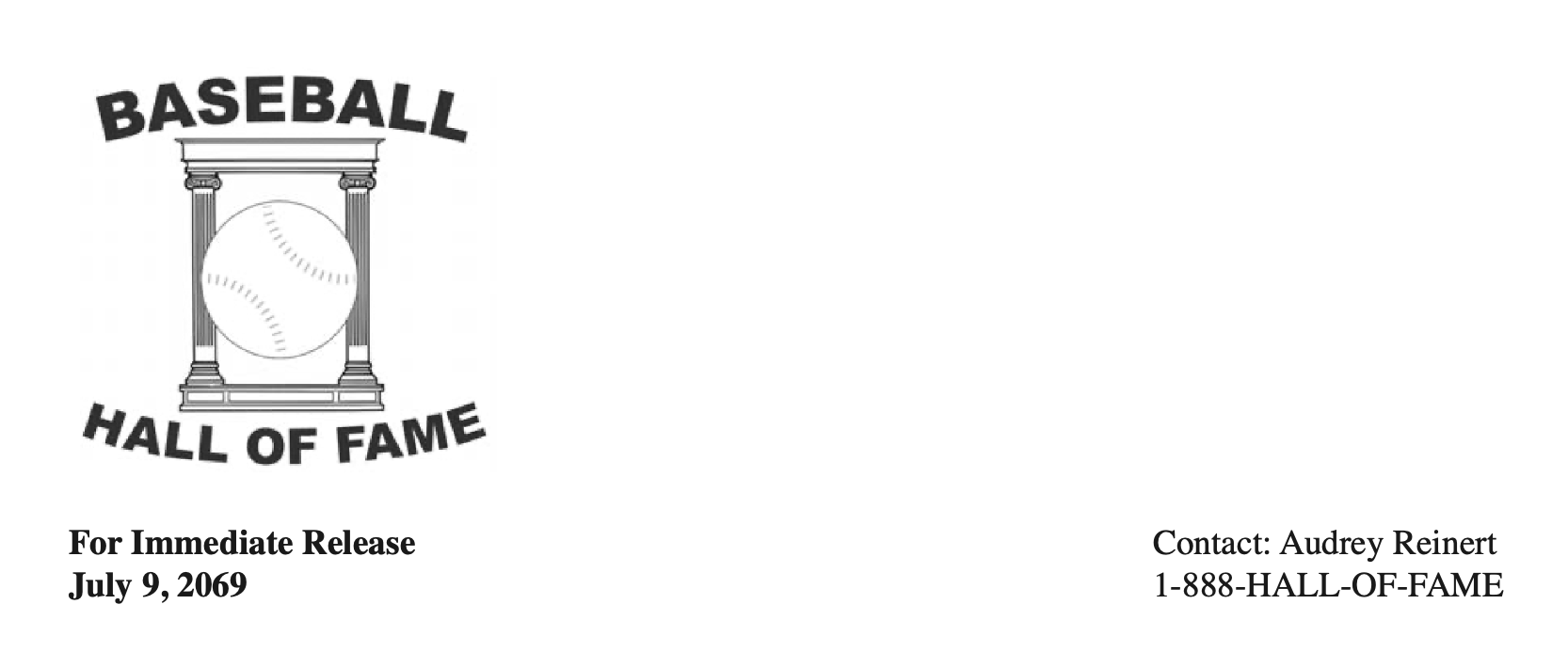Stevens Nomination to Hall of Fame to Proceed
This article was written by Audrey Reinert
This article was published in The National Pastime: The Future According to Baseball (2021)
Editor’s note: This article is a fictional press release from our special issue of The National Pastime looking ahead to the future of baseball in the 21st century.
STEVENS NOMINATION TO HALL OF FAME TO PROCEED
(COOPERSTOWN, New York) — Simon Ng, President of the Baseball Writers’ Association of America (BBWAA), announced today that the BBWAA will reconsider their previous stance on inducting Jared Stevens and other “enhanced individuals” into the National Baseball Hall of Fame in Cooperstown, New York. “In light of recent developments, the BBWAA has decided to reexamine the eligibility criteria for augmented individuals,” Ng told reporters via streamcast.
Jared Stevens, former pitcher for the St. Louis Cardinals, was first nominated for induction into the Hall of Fame in 2063, but his nomination faced stiff resistance from the electors. Those who voted in his favor cited his performance in Games Two and Four of the 2055 World Series against the Milwaukee Brewers, in which he pitched perfect games, in addition to his advocacy work with the Special Olympics, as grounds for induction. Those who voted against his induction noted that Mr. Stevens’s bionic pitching arm provided him a distinctly unfair material advantage compared to other pitchers.
Meredith Cartwright, president of the BBWAA from 2060 to 2065, had likened the decision to classify Mr. Stevens’s bionics as an unfair advantage to the BBWAA’s attitude on performance-enhancing drugs. During Cartwright’s tenure, the BBWAA modified their induction criteria to include the Cartwright Rule. The Cartwright Rule stated that enhanced individuals were ineligible for induction into the Hall of Fame.
The rule originally defined an enhanced individual “as a person who has received one or more significant augmentations including bionics, prosthetics, and other non-biological implants that provide them palpably unfair advantage during gameplay.” Contemporaneous BBWAA members noted that the definition of “enhanced individuals” in the rule was sufficiently broad that it could include anyone who had any reconstructive surgery, such as “Tommy John” UCL replacement, and objected to the definition on the grounds that it was too vague to be enforceable. The rule was subsequently revised after disability advocates noted that individuals who relied on assistive devices or reconstructive surgeries would be unfairly disqualified from consideration.
Once revised, the Cartwright Rule included a controversial test to determine if an augmentation or enhancement provided a player with a “palpably unfair advantage.” First, the augmented individual had to provide clear documentation that their augmentations were medically necessary. Second, the enhancements—including bionics and cyber physical augmentations — could not be further modified or altered beyond regularly scheduled maintenance and updates. Records of these updates were to be made available to opposing teams and MLB officials upon demand. Finally, an enhanced individual’s performance had to be within the 95% percentile of all active players.
Michael Stuber, an early advocate of Mr. Stevens’s nomination, noted that Jared had lost the arm at an early age and had been using commercially available bionics for most of his life. “Jared never concealed the fact that he was pitching using a bionic arm during his storied career,” Stuber wrote in 2063. “He was transparent about the specific make and model he used and allowed the members of the National Baseball Association to examine his arm prior to each pitching appearance. There were no substantiated complaints regarding his performance during his career from fellow players. It seems odd that we should object to his inclusion in the Hall of Fame when the sport’s governing body and the players’ union found no credible evidence of misconduct.”
Cartwright defended the rule stating that Stevens’s bionic enhancements increased the average speed of his pitch beyond that of an average unmodified pitcher. But numerous statistical analyses of Mr. Stevens’s pitching career failed to find sufficient evidence that his bionics meaningfully improved his performance.
The most damning condemation of the rule came from Edgar Rojas, former pitcher for the Brewers between 2053 and 2060. Despite a chilly onfield relationship between Rojas and Stevens during their careers, the two men would later found a charity together, dedicated to increasing involvement in youth sports. “If anyone had grounds to complain about Jared’s enhancements presenting an unfair advantage, it was the 2055 Brewers. I remember the attitude in the locker room after Game Four being grim and a few guys were upset. Can you blame them though?” Rojas said in a 2043 interview. “Players should be judged by what happened on the field, and what Jared did on the mound was unbeatable.”
AUDREY REINERT is a Postdoctoral Researcher at the University of Oklahoma’s Data Science Institute for Societal Challenges (DISC Center). She holds a PhD in Industrial Engineering from Purdue University (2019), a Masters in Human Computer Interaction from the Georgia Institute of technology (2015), and a Bachelors in Cognitive Neuropsychology from the University of California, San Diego (2012). Her research interests lie at the intersection of human centered computing, data visualization, and human machine interaction. She is a member of IEEE, HFES, and the AGU and can be reached at areinert@ou.edu.



